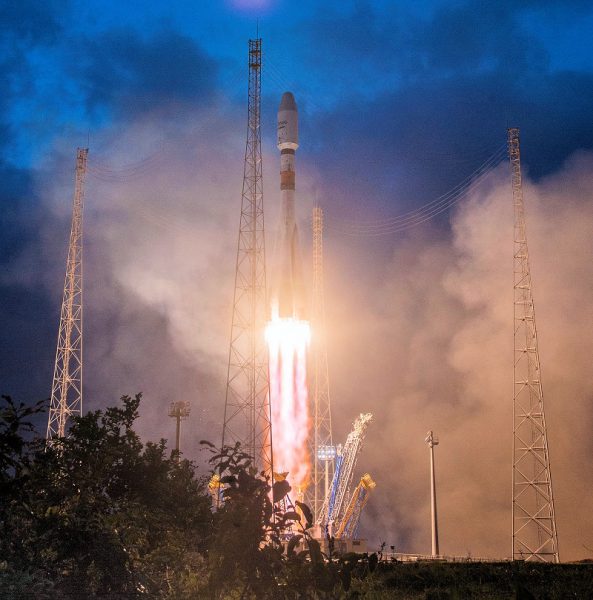OneWeb Set to Restart Launches of LEO Broadband Satellites

Space company OneWeb, which is now owned by a consortium of the UK Government and Indian conglomerate Bharti Global (here), has today confirmed that they will begin sending their high-speed broadband capable Low Earth Orbit (LEO) Satellites into orbit again from December 2020.
At present OneWeb has 74 compact LEOs in orbit around the Earth and their original plan was to kick things off by building a modest constellation of 648 satellites (they have approval for a total of 2,000), which would have been enough achieve a reasonable level of global coverage by around the end of 2021. Sadly, all of this was thrown into doubt earlier this year, when the company filed for voluntary relief under Chapter 11 of the Bankruptcy Code in the USA.
Since then the British-registered company has recently been scooped up by the aforementioned consortium for £800m ($1bn) and we’ve been patiently awaiting news of their future plans. The good news is that OneWeb has today confirmed their intention to restart launches in December 2020 via an amended contract with rocket firm Arianespace.
Advertisement
The amended agreement with Arianespace provides for 16 launches placing another 34-36 satellites per launch into OneWeb’s growing constellation. OneWeb’s return-to-flight launch in December will thus increase their in-orbit fleet to 110 satellites. The company plans to commence commercial services “above 50 degrees north latitude” by the end of 2021 and achieve the “deployment of its full global constellation” by the end of 2022.
Naturally the United Kingdom, as well as Alaska, Northern Europe, Greenland, Iceland, the Arctic seas and Canada, will be among the first regions to benefit from access to the new satellite based broadband connectivity when it goes live next year. Initially the new network will focus upon delivering “enterprise-grade connectivity services for communities, businesses and governments.”
However, the amended agreement remains subject to confirmation and consummation of OneWeb’s restructuring plan, although that is currently more of a formality. Meanwhile OneWeb’s joint venture partner, Airbus, is already busy ramping-up the pace of production and execution to meet the upcoming launch schedule (here). Closure of the current sale process is now expected in Q4 2020.
The low altitude of such spacecraft enables them to deliver significantly faster latency and, eventually, “fibre-like” broadband ISP speeds have also been promoted for remote areas. One early test from last year hit speeds of 400Mbps and delivered an average latency of 32ms, which is impressive for a Satellite technology (existing satellites are usually much slower) but it’s unclear what end-users can expect.
Advertisement
The huge double-decker bus sized geostationary orbit (GEO / GSO) satellite(s) of old sit many times further away from Earth (distance of about 35,000km+ vs around 1000km for LEOs) and have significant coverage, but their snail like latency times and limited capacity are a disadvantage for broadband performance. Likewise, each one takes years and hundreds of millions to build, which makes them slow to adapt.
We should point out that 1,280 of the currently approved plan for 2,000 satellites will actually sit in a higher medium Earth orbit of 8,500km and that could have a mild impact upon those latency times, albeit with better coverage. OneWeb also filed another application in May 2020 to seek approval for 47,844 satellites (here), albeit at their current altitude of 1,200km, but that will probably take a long time to be cleared and they’d needed masses of extra funding to achieve that.
The catch is that OneWeb, much like SpaceX, are likely to become the target of rising anger from astronomers, particularly if the LEOs turn out to be as disruptive to astronomical observation science as feared. Meanwhile others remain concerned about the impact on “space junk” and the growing potential for collisions, although LEOs seek to manage that by having a short lifespan and will de-orbit to help control the problem.
Mark is a professional technology writer, IT consultant and computer engineer from Dorset (England), he also founded ISPreview in 1999 and enjoys analysing the latest telecoms and broadband developments. Find me on X (Twitter), Mastodon, Facebook, BlueSky, Threads.net and Linkedin.
« Virgin Media UK Build Full Fibre to 14,000 Burgess Hill Homes























































it’s so they can send 5G microwave beams into your brain from space.
to make you buy premium bonds oh and give you corona too just because.
I have no idea what conspiracy theory you are trying to push here.
Wonder if the UK government is considering using this for a GPS solution too? (once we “finally” leave the EU without a deal!)
They did initially appear to hint at that in a supportive role, but more recently they’ve tended not to mention it, so your guess is as good as mine.
We’ve already left Buggerlugz, with a “fantastic, oven ready deal”… (-‸ლ)
The OneWeb satellites aren’t appropriate for GPS-type use. In particular:
* The OneWeb satellites aren’t in suitable orbits for a GPS-type system. MEO orbits are needed to avoid gravitational resonances and permit precise orbit prediction – the satellite’s position needs to be known at all times to centimetre accuracy. Also, the higher MEO orbits are needed for direct line of sight amongst buildings – the signals need to be received directly, not reflected off surfaces.
* Atomic clocks (and more besides) are needed on board the satellites and this can’t be added post launch – time is needed on board to nanosecond accuracy.
* It’s also worth noting that four times as many satellites are needed so that at least 4 are visible from the ground to triangulate a position fix.
GPS-type use of OneWeb satellites is a non-starter!
I suspect the UK government was disingenuously suggesting it to make the investment appeal to more people.
Yeah, I agree, although I would say it was more of a ruse to let the EU believe Galileo is not important to us. It’s bound to be something the EU was trying to use as a bargaining chip. The UK government having a foothold in a company building satellites is a stepping stone closer to developing a gps system (even if it does take a decade).
It may also provide additional benefits, such as a backup internet service for government, and connect hard to reach places.
So i’m not opposed to the deal per se , but if they make a success of it is another matter.
Stanford University says you’re wrong –
“… we look towards the changing market of space. New players are coming with proposals to build constellations of hundreds and even thousands of satellites in low Earth orbit (LEO). Their aim is delivering Internet to the world by providing global broadband coverage. We focus on how such constellations could be leveraged to carry a hosted payload, allowing them to act as navigation satellites. This unprecedented number of satellites gives rise to better geometry than GPS, enabling the use of lower cost clocks. This coupled with the more tranquil LEO radiation environment, allows for a design based on low cost commercial-off-the-shelf (COTS) components. Furthermore, moving from a medium Earth orbit (MEO) where GPS is today down to LEO significantly reduces path loss and makes us more resilient to jamming. …”
Presentation –
http://web.stanford.edu/group/scpnt/gpslab/website_files/LEO_sat_nav/ION_GNSS_2016_LEO_Navigation_Reid.pdf